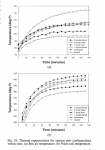Re: Heat buildup in sealed boxes
The large majority of the power dissipated by a speaker driver goes into heat rather than acoustic energy, so I would guess you could approximate the heat radiated into the box as the wattage the speaker is drawing, knowing you are only overestimating slightly. That suggests that there would be substantial heat buildup in a typical live sound application with a thousand watts or more powering a sealed sub all night. Power compression even with reflex ported subs is a common problem. I think power compression rather than burned voice coils will be your main enemy, and I would predict this could happen a lot sooner with the magnet inside a sealed box. How much the driver voice coil heats up depends on wattage it draws, voice coil / magnet design, volume of the box, efficiency of production of sound energy vs thermal energy, thermal conductivity of the metal speaker frame, stuffing of the box, porting or not, proximity of the magnet to the ports, and other factors. Most of these factors would be difficult to model and predict. Empirically measuring the heat in a prototype would seem to be the most practical way.
I built a sealed 12" sub for my recording studio monitors but I never use more than a quarter or half of the max power handling of 300 watts RMS. Even so I have considered building sealed subs for live sound use (very small gigs) and thought a lot about putting the magnet on the outside where airflow will ventilate and cool it. As I remember from my BassBox Pro simulations, the box volume isn't critical so you may want to just go ahead and build a prototype of the magnet-outside design, mount the driver with the magnet inside, and actually measure the magnet temp rise inside the box at full SPL. If it is insignificant, you can build the rest of your boxes with the magnet inside. If it gets too hot, build the magnet outside design. Since power compression will likely be the predominant SPL-limiting factor, I personally would bet on the magnet-outside design for your first prototype.
If you have a bass reflex sub with a similar wattage driver, you might want to just put a temp probe on the magnet, stuff some thermal insulation in the ports and crank it up to just below the power handling rating of the driver.
Or you could wait for Art Welter or someone else who actually knows from experience what they are talking about to comment!



